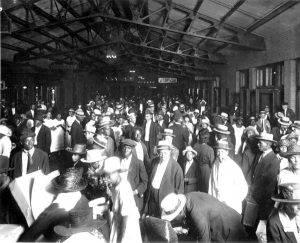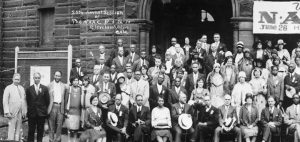Railroad Concourse in Jacksonville, Florida (1921)
 The image above depicts a group of African Americans at a railroad concourse in Jacksonville, Florida. The train is headed to Newark, New Jersey and the passengers abroad are in search of a better life. Between the years 1916-1940 it is estimated that around two million African Americans migrated to Chicago, Philadelphia, New York and other nothern cities. African Americans mainly migrated to get away from racist segregation laws and restrictions on sharecropping. Northern cities saw a gigantic change in demographic and some neighborhoods were 40 percent African American. African American men found jobs in factories and slaughterhouses, while African American women found work in the domestic field. Improved wages, creation of black schools, universities, and churches helped create a black middle class. The Great Migration led African Americans to work together and trust each other. Migrating to the North was a risk, however, African Americans were fed up and understood that the quality of life could only improve.
The image above depicts a group of African Americans at a railroad concourse in Jacksonville, Florida. The train is headed to Newark, New Jersey and the passengers abroad are in search of a better life. Between the years 1916-1940 it is estimated that around two million African Americans migrated to Chicago, Philadelphia, New York and other nothern cities. African Americans mainly migrated to get away from racist segregation laws and restrictions on sharecropping. Northern cities saw a gigantic change in demographic and some neighborhoods were 40 percent African American. African American men found jobs in factories and slaughterhouses, while African American women found work in the domestic field. Improved wages, creation of black schools, universities, and churches helped create a black middle class. The Great Migration led African Americans to work together and trust each other. Migrating to the North was a risk, however, African Americans were fed up and understood that the quality of life could only improve.
The Weary Blues, by Langston Hughes (1926)

The Weary Blues describes blues music being performed in Harlem, New York. After listening to a Blues performance, it inspired Hughes to reflect on his own experiences. Hughes is one of the first poets to combine poetry and Blues music. Blues music was invented by African Americans as a secular counter to old slave spirituals. Blues was often performed in a solo manner in order to emphasize despair, loneliness, and frustration. The language in the poem describes the deep pain that African Americans have experienced over the past few years. The poem took place during the peak of the Harlem Renaissance. With the conclusion of the Great Migration, African Americans had difficulty finding homes, which led them to create all black towns within cities. Harlem, New York became a central location for African American poets, musicians, lawyers, entertainers, and unskilled laborers. African Americans alike came together to support each other and start a new life. African Americans were able to be self sufficient in order to have the necessary resources to survive. Unfortunately, the Harlem Renaissance ended due to the Great Depression, nonetheless it had a strong impacted that proved when African Americans work together, they truly can make a change.
W.E.B Du Bois and the NAACP (1929)
The NAACP (National Advancement of Colored People) is a civil rights organization that aims to eliminate racial discrimination. The image above shows a meeting of founding members, one of which is W.E.B DuBois. The founders have just concluded a national meeting and assigned different roles and responsiblities in order to expand. The image displays Thurgood Marshall, W. E. B. DuBois, Ida B. Wells-Barnett, and Mary Church Terrell all of which who decided to work together for the common good. W.E.B Dubois was a man with many attributes, one of which included being the first African American to graduate Harvard with a doctorate degree and he later went on to become a professor of history. Dubois was a writer and one of his famous writings is The Souls of Black Folk which is a collection of essays depicting the Black experience in America. DuBois and the other founders put aside their individuals aspirations, in order to leave a lasting impact in history. In 1929, the NAACP fought to end racial discrimination in the military, employment segregation, and racial violence to name a few of their primary campaigns. The NAACP still exists today with chapters all around the country still having a forceful impact on civil rights.
